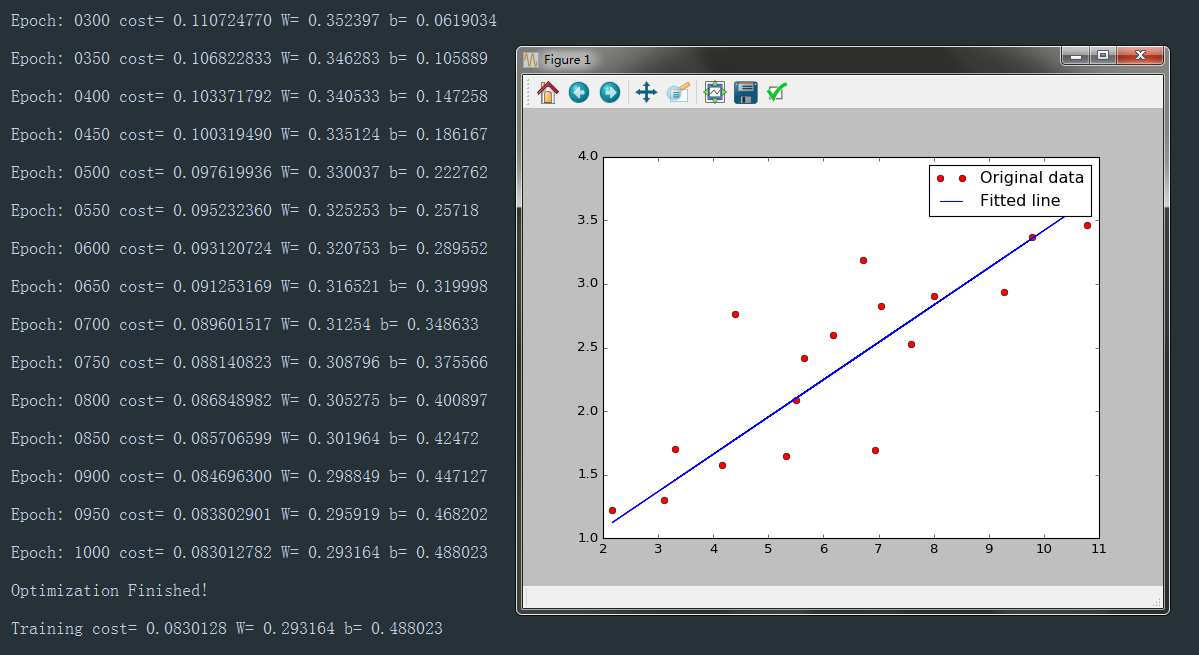上一节讲了tensorflow简单的运算,这节用简单的线性模型感受一下tensorflow和机器学习的一般操作。本章节只讲tensorflow的用法,如果对线性模型不了解的可以自行查阅,或者等博主有空写个专题(涉及基本原理和公式的推导)。
讲两个模型,线性回归(numpy造一些数据),逻辑回归(mnist数据集)
从线性回归开始
线性回归:找到一组参数,作用于样本的属性,使其预测结果与真实结果接近(自行理解接近)
用tensorflow求解参数W,b,拟合样本数据,并matplotlib展示
直接上代码吧
2
3
4
5
6
7
8
9
10
11
12
13
14
15
16
17
18
19
20
21
22
23
24
25
26
27
28
29
30
31
32
33
34
35
36
37
38
39
40
41
42
43
44
45
46
47
48
49
50
51
52
53
54
55
56
57
import numpy
import matplotlib.pyplot as plt
#params:设定超参数
learning_rate = 0.01
training_epochs = 1001
train_x = numpy.asarray([3.3,4.4,5.5,6.71,6.93,4.168,9.779,6.182,7.59,2.167,
7.042,10.791,5.313,7.997,5.654,9.27,3.1])
train_y = numpy.asarray([1.7,2.76,2.09,3.19,1.694,1.573,3.366,2.596,2.53,1.221,
2.827,3.465,1.65,2.904,2.42,2.94,1.3])
n_samples = train_x.shape[0]
#需要注意的是当train_x是向量形式时,他的表示方式。
print(train_x.shape)
#线性回归,找到一组参数,作用于x,使其接近于y
X = tf.placeholder('float')
Y = tf.placeholder('float')
#w参数一般会给一个非0的初始值,取名为weights,b为偏移
#不加说明的命名规范,矩阵用大写
W = tf.Variable(numpy.random.randn(),name='weights')
b = tf.Variable(numpy.random.randn(),name= 'bias')
#预测结果
pred = tf.add(tf.multiply(X,W),b)
#定义损失函数,一般线性回归用均方误差即可(别告诉我你不知道分母为什么)
cost = tf.reduce_sum(tf.pow(pred-Y,2))/(2*n_samples)
#定义优化器,这里选择随机梯度下降
optimizer = tf.train.GradientDescentOptimizer(learning_rate).minimize(cost)
#初始化定义的变量
init = tf.global_variables_initializer()
with tf.Session() as sess:
sess.run(init)
#训练模型
for epoch in range(training_epochs):
for (x,y) in zip(train_x,train_y):
sess.run(optimizer,feed_dict={X:x,Y:y})
if epoch % 50 == 0:
c = sess.run(cost,feed_dict={X:train_x,Y:train_y})
#每50次看一下训练的效果
print("Epoch:", '%04d' % (epoch), "cost=", "{:.9f}".format(c),
"W=", sess.run(W), "b=", sess.run(b))
print("Optimization Finished!")
training_cost = sess.run(cost, feed_dict={X: train_x, Y: train_y})
print("Training cost=", training_cost, "W=", sess.run(W), "b=", sess.run(b), '\n')
#画图,这里的'ro'r指的red,o指的是散点图
plt.plot(train_x, train_y, 'ro', label='Original data')#加0变成散点图
plt.plot(train_x, sess.run(W) * train_x + sess.run(b), label='Fitted line')
#legend显示label
plt.legend()
plt.show()
程序截图

逻辑回归
逻辑回归:在线性回归的基础上,用sigmoid函数对值域进行控制(0,1)之间,逻辑回归处理二分类问题,这里用mnist数据集,用softmax函数代替,损失函数用交叉熵代替。(不明白交叉熵就等我更新喽)
1 | from tensorflow.examples.tutorials.mnist import input_data |
程序截图
